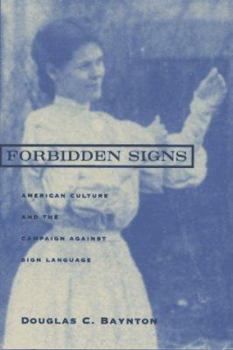Forbidden Signs: American Culture and the Campaign Against Sign Language
Select Format
Select Condition 
Book Overview
Forbidden Signs explores American culture from the mid-nineteenth century to 1920 through the lens of one striking episode: the campaign led by Alexander Graham Bell and other prominent Americans to suppress the use of sign language among deaf people. The ensuing debate over sign language invoked such fundamental questions as what distinguished Americans from non-Americans, civilized people from "savages," humans from animals, men from...
Format:Hardcover
Language:English
ISBN:0226039633
ISBN13:9780226039633
Release Date:December 1996
Publisher:University of Chicago Press
Length:235 Pages
Weight:0.85 lbs.
Dimensions:1.5" x 6.0" x 9.0"
Customer Reviews
3 ratings
Effectively speaks to all readers about a difficult period
Published by Thriftbooks.com User , 16 years ago
Juxtaposed against 'democracy' the oralism movement was fundamentally authoritarian to the core. Like the schools which missionaries set up to 'tame' the Indian tribes which they encountered, these institutions wanted to make the 'deaf and dumb' as they were once called, assimilate by any means necessary. Signing was considered backwards and primitive, speaking was thought to be the only 'civilized' marker of civilization. However, Douglas C. Baynton clarifies that at these institutions, the students practiced their own models of resistance. He also stresses that being deaf is not a limitation, but a distinctive culture, like Spanish or Polish is commonly thought of. Therefore it is impossible to obtain a complete translation between English and ASL in all cases. Academic works can be pretentious, but this was a definite page turner. I felt a little let down that his chronicled history did not examine the 20th century. It would be interesting to see what forms this campaign is taking in an era when people with disabilities are supposed to be included in greater public participation. I doubt that it completely disappeared. Plus the transformation of Gallaudet University from a site of oralism to the DPN now protests and open embrace of ASL could have provided interesting research certainly within this book's reach. It remains an important work in the too under-known field of disability studies.
Let's all stop Dumbing the Deaf Down.
Published by Thriftbooks.com User , 23 years ago
The book was sensitive and beautifully written.There are many things still forbidden to the deaf in the year 2,000 (disgraceful)! Here are a few more sundry attempts to prevent the deaf from exploring their right to fully communicate or make their language fully credible, valuable and valid. I call it DDD or Dumbing the Deaf Down. 1. The linguists, educators and interpreters all say sign language is a visual language, therefore it cannot have a written form. Even the deaf have bought this myth hook, line and sinker. To prove my point, English is a vocal language. Does that mean English should not have books filled with words? No one should be able to write letters, type, keep documents etc.? How loonie that would be. 2. The experts all say, "Home signs are invalid", there's "no use for them", they are "wrong" and they "arn't accepted" (by the Ph.D. community I guess), etc. Who's language is it anyway? Why shouldn't all signs be documented? Why should some signs die when the old deaf ones pass on? Why shouldn't there be a 2 way sign language dictionary that anyone at any age could access? Have no fear! A team of concerned parents are doing just that. As of this writing there are 9,000 signs in written form, and 3,000 left to finish. 1,800 signs are now in alphanumerical order with 10,200 left to be placed in a 2 way dictionary. If anyone has a problem with this and wishes to debate the issue, I'll be more than happey to oblige. wercozy@wvi.com
Absolutely stunning.
Published by Thriftbooks.com User , 23 years ago
Quite honestly, I expected to be bored out of my wits by this book. The subject matter was interesting, but it started out as Baynton's doctoral dissertation, for goodness' sake! It was going to be a dryly written academic bog.Wrong. Baynton's style is witty and positively lyrical, a pleasure to read. Indeed, I was surprised at the short time it took me to finish.This is not to say that the book suffered from a lack of hard content- far from it. If "When the Mind Hears" intrigued you, "Forbidden Signs" will leave you riveted. Baynton reaches startling conclusions which are so logical that, in hindsight, they seem self-evident. Of particular interest was his chapter on gender in the oralist movement- you definitely won't see that one coming!I hate to seem excessively gushy, but Baynton has produced a marvel. I only hope there's an equally good sequel in the works. :c)




